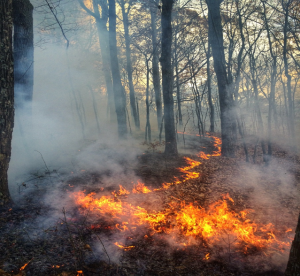Detailed descriptions of the pre-treatment conditions for each of the communities being studied can be found in The Hardwood Ecosystem Experiment: A Framework for Studying Responses to Forest Management.
Vegetation: Forest Dynamics, Digital Forestry, Acorn Production
Birds: Breeding birds, Cerulean warbler
Mammals: Bats, Small mammals
Reptiles & Amphibians: Salamanders
Insects: Wood-boring beetles and Moths (Lepidoptera)
Fire: Prescribed fire
Fungi: Ectomycorrhizal fungi
Hardwood Ecosystem Experiment Species List, 2006-2015 (PDF: 204 KB)
This list includes all species documented since the initiation of the HEE in 2006.
Vegetation
Forest Dynamics
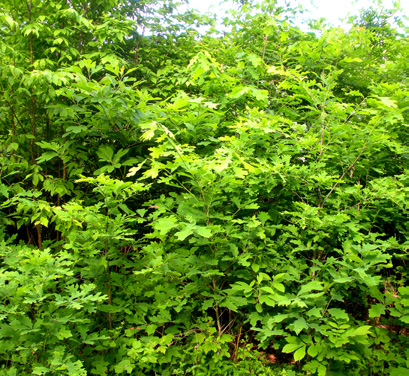
Project Investigators
Mike Saunders, Purdue University, msaunder@purdue.edu
Mike Jenkins, Purdue University, jenkinma@purdue.edu
Wildlife managers face a conundrum when asked to manage a species that requires a specific type of sub-climax habitat. If you remove the habitat, you lose the animal. Conversely, if you leave the habitat alone, it will become over-mature and eventually cause a decline of the species. This is the issue facing wildlife biologists and timber managers in Indiana where many of our species are dependent on Oak/Hickory forests. For many years, these forests have been allowed to grow without harvest or fire, and the result is that the understory of these woods is now filled with species such as maples and beeches that are the true local climax habitat.
Inventory plots are being installed to characterize the long-term, landscape-level changes in forest canopy structure and overstory recruitment by oak and other highly valued tree species in response to forest management. These plots will also allow spatial modeling of oak regeneration in response to overstory canopy and other environmental valuables, thereby linking local, seed dispersal mechanisms to the landscape pattern. Data concerning herbaceous plants and seedlings is also recorded at these same plots. Plots are installed across all treatment types on a 75 meter by 150 meter grid, linking them to avian inventories and, eventually, an associated dead wood inventory.
Digital Forestry
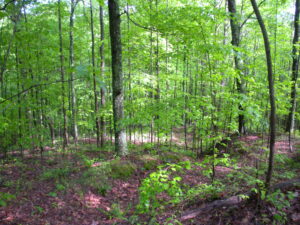
Project Investigator
Songlin Fei, Purdue University, sfei@purdue.edu
https://ag.purdue.edu/digital-forestry/
Sustainable forest management requires detailed inventories of tree quantity and quality to support informed management decision making, which in turn, can significantly impact the potential for forest resources to meet economic and ecological needs. Forest inventory data is currently collected using manual field sampling techniques, often relying on observations by trained experts, introducing substantial sources of error and reducing reproducibility of data collection effort. Recent technological advances offer new methods and techniques that can increase the accuracy of tree quantity and quality measurements, and are cheaper and faster than conventional approaches.
We plan to modernize forest inventory at the Hardwood Ecosystem Experiment (HEE) site by developing methods that take advantage of recent advances in aerial remote sensing technologies and the vastly available ground data. Specifically, we plan to (1) test the feasibility of automated individual tree delineation and biometrics measurement for natural hardwood forests at HEE using unmanned aerial system (UAS) LiDAR and multispectral images, and (2) test the feasibility of UAS based invasive species mapping.
Acorn Production
 Project Investigator
Project Investigator
Robert K. Swihart, Purdue University, (765) 494-3575, rswihart@purdue.edu
Dr. Swihart is studying acorn production and removal of fallen acorns to determine which consumers in the forest community are benefiting from this important food supply, how use varies with food availability and consumer density, and whether differences occur due to tree harvesting. Acorn traps have been placed under the canopies of >100 oak trees, and acorns collected by traps are counted during regular checks from August-December. A subset of acorns is x-rayed each year to determine whether they are infested by acorn weevils. At each tree, a series of semi-permeable enclosures is used to restrict access to acorns by vertebrates of different size, from deer to mice. During the first 6 years post-harvest, there was little effect of silvicultural treatments on acorn production except for a reduction in black oak acorns along opening edges. Weevil infestation was reduced following midstory removal in shelterwood treatment sites, and predation pressure by weevils and vertebrates was greatest during years of low acorn production (Kellner, Riegel, and Swihart 2014). Mast production also was associated with relative abundance of white-footed mice and short-tailed shrews the following summer (Kellner, Urban, and Swihart. 2013). Acorn production and weevil infestation data also were used to build a model to simulate the importance of multiple aspects of oak early life history and demography on oak regeneration success. Regeneration success was most sensitive to acorn production, the probability of acorn caching by scatter hoarding rodents, and seedling growth rates (Kellner and Swihart 2017). In related work, we studied the dispersal of acorns and found that acorns from sites treated with midstory removal were more likely than untreated sites to be taken by granivores and were less likely to survive the winter, resulting in a 67% reduction in seed dispersal effectiveness (Kellner, Lichti and Swihart 2016).
Birds
Breeding Birds
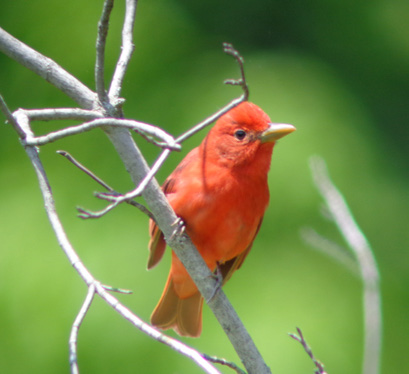
John B. Dunning, Purdue University, (765) 494-3565, jdunning@purdue.edu
Many species of songbirds that nest in mature forests of the eastern United States are declining, and it is thought that forest management activities may be part of the cause for the declines, but also may be part of the solution. Since the beginning of the HEE project, field technicians under the direction of Dr. John Dunning of the Department of Forestry and Natural Resources have conducted surveys of breeding birds at the HEE study areas to establish the distribution and abundances of species across the sites and to monitor how the bird communities change in response to forest management.
Since the first timber harvests, we have looked at how birds respond, not only at the specific sites where timber management is conducted but also across the larger spatial scales of the HEE project. Birds are surveyed with 10-minute point counts, during which field technicians record all birds seen and heard within 100 meters of permanently marked locations. Melissa Malloy, who received her master’s degree from the Purdue University FNR department, focused initially on predicted changes in the distribution of common breeders across the study regions in the first years after the harvests, while Patrick Ruhl, who finished a Ph.D. in the same department, and Ken Kellner, a post-doctoral researcher, looked at longer term impacts on both species distribution and breeding success. While all birds are surveyed, some species are of management or conservation concern, and therefore are of special interest. These include migratory songbirds such as the Wood Thrush and Scarlet Tanager, resident species such as Blue Jays that play important ecological roles as nest predators and acorn dispersers, and unusual birds such as the Golden Eagles, which winter locally in the region and the Worm-eating Warbler, a habitat specialist that breeds in the steep forested slopes of southern Indiana. Surprisingly, Worm-eating Warblers have proven to be one of the most common species caught during the breeding season in the clearcuts in later years, when those patches are densely vegetated with early succession shrub and tree species. The role of the young forest habitat in the clearcut patches was a major focus of Patrick Ruhl’s research, which involved banding territorial birds in the clearcuts over several years.
Cerulean Warbler

Project Investigator
Kamal Islam, Ball State University, (765) 285-8847, kislam@bsu.edu
Dr. Kamal Islam and his students at Ball State University have been studying the Cerulean Warbler in southern Indiana since 2000. This tiny migratory songbird of conservation concern has experienced long-term population declines on its breeding grounds during the past 45 years. We are trying to understand factors responsible for the decline of this species in Indiana, where it is listed as ‘endangered’. Although Cerulean Warblers are generally associated with mature forests, their territories are often characterized by canopy gaps, and these birds are attracted to small openings in the forest created by various forest practices. The presence of Cerulean Warblers in selectively-cut stands suggests that canopy gaps are likely an important habitat variable. Our primary objective in the context of the HEE is to determine how Cerulean Warbler populations respond to different forest treatments by 1) measuring estimates of relative abundance and 2) quantifying reproductive output. An additional research question links the importance of arthropod abundance in oaks and hickories (compared to other tree species), and Cerulean Warbler adult and nestling diet. Recently, we have expanded our research to include fledgling dispersal using radio-transmitters. Evidence from studies of other migratory songbirds suggests that fledglings of mature forest species move into early successional habitats, such as those created by forest harvest. Results from our studies have potential management implications for the conservation of this declining species.
Mammals
Bats
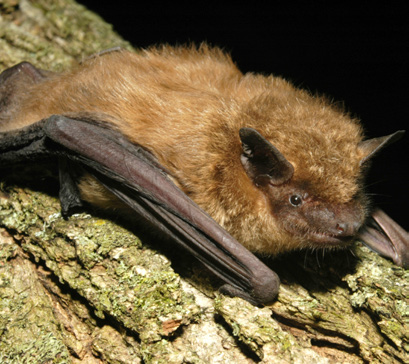
Project Investigators
Joy O’Keefe, University of Illinois, (217) 300-6933, jmokeefe@illinois.edu
For many species of wildlife, particularly game animals such as deer and turkey, we have enough scientific knowledge to predict the results of timber harvest on local populations. Such is not the case for the endangered Indiana bat (Myotis sodalis). Part of the problem is that these bats spend their summers in old dead or dying trees with loose bark. In these snags the females form large colonies (often with 100+ individuals) and raise their young. So biologists are very concerned that timber harvest will either remove the roost trees or the next generation of roost trees.
Although Indiana bats will use almost any large tree with sloughing bark and substantial solar exposure, oaks and hickories seem to be some of the better roosts because one dead tree will hold onto its bark for many years. Maples are rarely used and seem not to form high quality roosts, while no one has ever recorded an Indiana bat using a beech. Thus, we also face a situation that as oak-hickory forests become beech maple forests, they may become less valuable to bats. One way of turning back the clock on succession is by using timber harvest—the overall goal of Hardwoods Ecosystem Experiment is to determine the impact of harvest on a wide variety of wildlife.
To determine the impact of timber harvest on bats we are “trapping” bats in 2 ways. First, we are using mist-nets to capture them as they fly through an opening in the forest. This allows us to directly handle the bats and determine their age, sex, reproductive state, even if they have been captured before. Unfortunately, mist-nets are only effective when placed in an area, such as a roadway or stream, where bats are funneled into the net. Thus, they are not very good for detecting bats that are simply flying through, or over a forest. To “trap” these bats we are using a device called an Anabat® Detector that converts the echolocation calls of bats into an electronic file. Once these data are stored, we can go back and identify many of the calls to species. This technique allows us to “capture” many more bats, but we do not have the detailed information about the individuals such as we get from netting.
Small Mammals
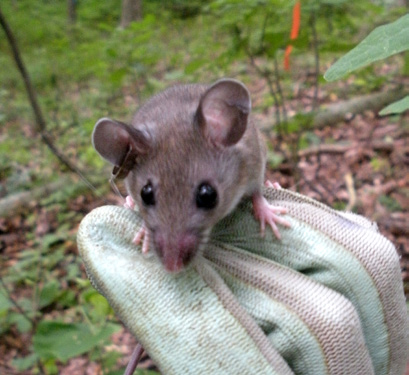
Project Investigator
Robert K. Swihart, Purdue University, (765) 494-3575, rswihart@purdue.edu
Elizabeth Flaherty, Purdue University, (765) 494-3567, eflaher@purdue.edu
Pat Zollner, Purdue University, (765) 496-9495, pzollner@purdue.edu
Small mammals are important but seldom-seen components of forest ecosystems. They play important roles as seed dispersers, seed predators, and food for larger animals. The Hardwood Ecosystem Experiment is studying the effect of forest management on small mammal populations and communities. Dr. Robert Swihart designed a study in which livetrapping grids were established at 32 sites during summer of 2007, and trapping has been conducted regularly since then to determine short-term responses of small mammals to harvesting. Attributes of habitat also were measured around each trap, in the area scheduled for harvest, and in each of the 900-acre management units, to assess whether certain attributes are consistently associated with use by small mammals. Eastern chipmunk numbers increased with harvest opening size – abundance was 38% to 84% greater than in unharvested sites. White-footed mice were unaffected by small to medium-sized openings but declined by 32% in the largest 10-acre openings. Short-tailed shrews tended to increase slightly in association with 1-acre openings but declined slightly in larger openings. Other factors also influenced abundance: numbers were lower for shrews and mice on sites with southwestern aspects and following years of poor acorn production. Chipmunks and mice benefited from increased woody debris created by harvests, but shrews avoided harvest areas without a well-developed layer of leaf litter.
We currently are evaluating effects of timber harvest and prescribed fire on the survival of small mammals and on their behavior as seed dispersers. Additionally, all captured white-footed mice, chipmunks, and pine voles will be marked for individual identification and then released at site of capture. When grids are not actively live-trapped, we also will survey those sites using a passive camera trapping method designed for small mammals. The combination of these two data sets will allow us to evaluate the noninvasive camera method for future efforts monitoring small mammal responses to silviculture treatments over time.
Reptiles & Amphibians
Salamanders
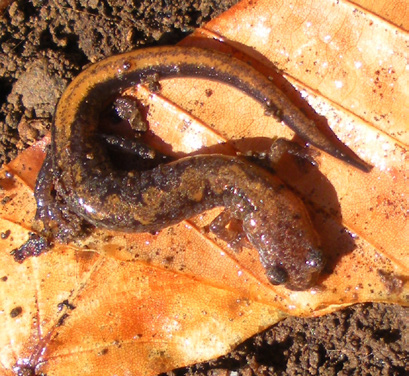
Project Investigator
Robert K. Swihart, Purdue University, (765) 494-3575, rswihart@purdue.edu
Terrestrial plethodontid salamanders are an ideal group of species to monitor forest ecosystem integrity and biodiversity across the eastern United States. They play a significant role in nutrient recycling by consuming vast quantities of invertebrates and in turn serve as prey items for other forest species. They are sensitive to environmental stresses, and they are often the most abundant vertebrates in deciduous forests.
However, our current knowledge of the effects of timber harvesting on salamander populations is incomplete. Most studies suffer from a lack of replication among various silvicultural treatments and focus solely on immediate post-treatment responses. The terrestrial salamander portion of the Hardwood Ecosystem Project is designed to evaluate the effects of timber harvesting on the diversity, abundance, and demographics of woodland salamanders. Beginning in May 2007, a total of 66 coverboard grids (30 boards per grid) were placed within the 9 study areas. The coverboard grids were checked every other week from September through November. In the spring of 2008, nearly 2000 quadrat surveys (1x1m plots) were added to the coverboard sampling and the sampling period was extended to include Spring sampling in addition to the Fall sampling. We used the first years of data to evaluate the immediate response of plethodontid salamander populations in regenerating forests < 5 years old (MacNeil and Williams 2014). More recently, analysis was extended to the decade following the initial timber harvesting (Ochs, Saunders, and Swihart 2022). Ten species were counted under coverboards, with eastern red-back and zigzag salamanders dominating captures. Salamander declines were lagged, occurring 4-11 years post-harvest in clearcuts and patch cuts. Declines coincided with drops in levels of coarse woody debris and a regional drought. Negative effects of harvest extended from harvest boundaries only 20 m into surrounding forest. Salamander counts were unaffected by either midstory removal or removal of roughly 50% of overstory in shelterwoods.
Insects
Wood-boring beetles

Project Investigator
Jeffrey Holland, Purdue University, (765) 494-7739, jdhollan@purdue.edu
Jeffrey Holland of Purdue’s Department of Entomology is studying the influence of different types of forestry management on assemblages of longhorned beetles and jewel beetles. Some of these beetles are devastating pests of forest trees, while the majority play important ecological roles by decomposing rotting wood, acting as natural thinning agents, and pollinating flowering plants. Understanding how the assemblages of species changes over time under different management techniques will allow us to both promote those native species providing ecosystem services and limit economic losses from the few pest species.
So far, the project has found approximately 130 species of longhorned beetles and 40 species of jewel beetle. The different treatments are having markedly different influences on the wood-boring beetle community. In addition, these communities appear to be resilient to the treatments thus far with communities gradually returning to pre-harvest communities. Ongoing work is looking at the functional diversity response of the beetle communities and the spatial extent of the harvest influence.
Moths (Lepidoptera)
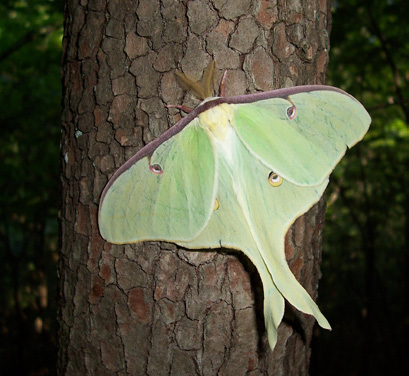
Project Investigator
Keith Summerville, Drake University, (515) 271-2265, keith.summerville@drake.edu
Dr. Keith Summerville’s goal for his contributions to the Hardwood Ecosystem Experiment is to develop a deeper understanding of how both anthropogenic and stochastic disturbances create structure in moth species assemblages. In particular, Keith is testing hypotheses related to the relative contributions of timber harvest, prescribed fire, variation in weather, and impact of timber pests on forest Lepidoptera. Based on the last 15 years research, Keith has determined that moth species assemblages are relatively resilient to timber harvests when some overstory hardwoods are left uncut and when unharvested stands are adjacent to managed sites. Late frosts (after mid-May),summer droughts, and high volume timber harvests appear to interact to create novel species assemblages dominated by generalist species. Low intensity burning of the understory has very limited impact of communities of forest Lepidoptera. Keith’s sampling methodology utilizes battery-powered light traps that draw the moths in and traps them in a funnel capped bucket. Twenty of these traps were set for five different nights in the summer of 2007-2022.
Oak forests in eastern North America were borne of fire. Fire shaped the species, the size and the spatial distribution of trees within these cherished forests. Over the past century, fire suppression and fragmentation has reduced the resistance and resilience of these forests to pests, pathogens, weather and changing climate. This is leading to a slow conversion of these oak forests to maple forests, which has important implications to the ecology and economy of eastern North America. For example, oak forests host more wildlife species, both old and young forest specialists, than most other forest types in the East. Due to the critical role that fire plays in regenerating oak, prescribed burning began in several areas in 2015. Over time, researchers are examining the effects of fire on vegetation, small mammal, bird, moth, beetle, and spider populations as well as the effects of fire on tree quality.
Fungi
Ectomycorrhizal fungi

Fungi are one of the primary drivers of ecosystem function; it is generally acknowledged that strong interactions and feedbacks occur between soil microbial communities and most plant species. Fungi play primary roles in decomposition, nutrient cycling, and carbon cycling – yet they remain vastly understudied across most biomes. In this work we are using a variety of approaches (fruiting body sampling, and next-generation sequencing analyses) to document the fungi of the HEE.
Traditional research of fungi in the environment primarily relies on specimen-based or culturing methodologies to assess the species that are present. The main body of fungi, called a thallus, are microscopic, present as threadlike filaments that are located underground or in various substrates such as trees and plant roots. Mushrooms, the “fruit” of the fungus are only produced following species-specific environmental cues, yet remain the most reliable source of identifications. Most mushroom-forming fungi are either involved in obligate symbioses with woody tree species (call mycorrhizae) or else are involved in carbon recycling. We are sampling mushrooms in the HEE, preserving them in the Kriebel Herbarium at Purdue, and using a variety of methods to identify them to produce a catalog of the macro fungal species. These data will be used to provide baseline information about the types of plant recycling and symbioses in the various forest types at HEE.
New technologies such as next-generation sequencing (NGS) allow us to take an environmental sample of soil or wood and to look at the DNA of all of the fungi that are present, but “hidden” in the ecosystem, which includes fungi that are not actively fruiting, or that do not form visible fruits. From a single small soil sample, it is possible to capture the presence of dozens, or even hundreds of fungal species. As a part of this research, we are examining the fungal communities that exist in the soil around five tree species – white oak, chestnut oak, tulip tree, beech, and sugar maple. We are also examining how these communities change across geographic and temporal gradients, as well as through a result of different forest management strategies with a focus on those that form mycorrhizae with these tree species.

